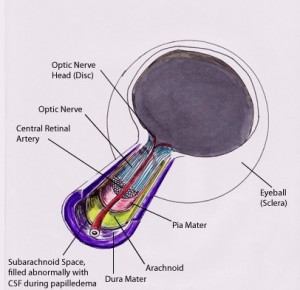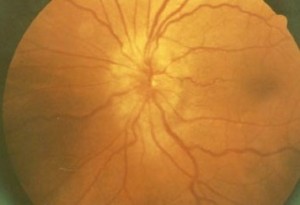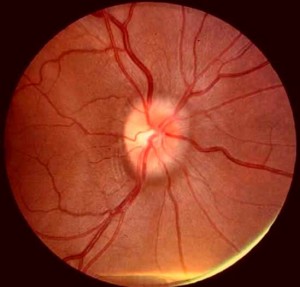Papilledema comes from the root word papilla or the optic nerve and edema meaning inflammation or swelling. Thus, it is the swelling of an optic nerve. Optic nerves are the ones carrying messages from the eyes to the brain. For example you see an umbrella, the optic nerve sends signal to the brain and the brain in turn lets you know that it is an umbrella, in other words, it helps you recognize things or translate things that you see.
There are a lot of causes for papilledema. Most cases are caused by intracranial pressure or increased pressure inside the skull. The best person to determine or check this condition is your doctor where he will make use of an opthalmoscope and lights this over your eyes. The light passes through your retina and an elevated optic nerve would confirm that an individual indeed has papilledema.
Papilledema Signs, Symptoms and Causes
Signs and symptoms of papilledema would commonly include:
• Headache – Due to the rise of pressure in the skull.
• Nausea and Vomiting – The individual may feel his head spinning constantly and vomits in the process.
• Occasional vision loss – When the optic nerves swell greatly, an individual would experience occasional vision loss.
• Loss of peripheral vision – The vision you can often see on the sides even if you’re looking in front will now narrow down.
• Alteration of vision – This is when you experience blurring of an object or occasional double vision.
Causes of Papilledema:
• Brain tumors – When a tumor forms inside the brain, pressure inside the skull will also develop, and that pressure will lead to the swelling of the optic nerve.
• Abscess – Abscess usually arises from an infection. This will form pus in the cerebellum (part of the brain). This will also increase pressure in the skull.
• Hypertension – Optic nerve swelling may also occur in individuals with severe hypertension. High blood pressure makes the blood vessels swell and those include the ones near the optic nerves.
• Hydrocephalus – This is when cerebrospinal fluid would enter the skull in great amounts, adding pressure to the skull and swelling the optic nerve in the process.
Papilledema Treatment
The first step to treat papilledema is to have it checked by a doctor. From there, the doctor would find the cause and find ways in order to treat the underlying problem that’s causing the papilledema. Upon detection, the doctor usually conducts a biopsy. If brain tumor is detected, it is usually removed by surgery or radiation. If the papilledema is caused by too much fluid and pressure inside the brain, lumbar punctures are done repeatedly in order to remove the excess fluid. The usual medicine prescribed by the doctor is Acetazolamide. This medicine helps lower the excess spinal fluids and bring down intracranial pressure in the process. If the papilledema is caused by an inflammation, anti-inflammatory drugs such as methylprednisolone and prednisone will help resolve the condition.
Papilledema is serious and must be reported immediately to your physician. The earlier you start with the treatment, the less likely it will become worse. Therefore, prompt action should be taken.
Papilledema Pictures
Here are pictures of Papilledema where we see the optic nerve and how it is affected by the disease.



What i do not understood is if truth be told how you are now not really a lot more neatly-preferred than you may be now. You are so intelligent. You realize therefore considerably in the case of this topic, made me personally imagine it from a lot of numerous angles. Its like men and women aren’t fascinated except it is one thing to accomplish with Girl gaga! Your personal stuffs excellent. All the time deal with it up!